Jinfeng Xu
Towards Pixel-Wise Anomaly Location for High-Resolution PCBA via Self-Supervised Image Reconstruction
Dec 22, 2025Abstract:Automated defect inspection of assembled Printed Circuit Board Assemblies (PCBA) is quite challenging due to the insufficient labeled data, micro-defects with just a few pixels in visually-complex and high-resolution images. To address these challenges, we present HiSIR-Net, a High resolution, Self-supervised Reconstruction framework for pixel-wise PCBA localization. Our design combines two lightweight modules that make this practical on real 4K-resolution boards: (i) a Selective Input-Reconstruction Gate (SIR-Gate) that lets the model decide where to trust reconstruction versus the original input, thereby reducing irrelevant reconstruction artifacts and false alarms; and (ii) a Region-level Optimized Patch Selection (ROPS) scheme with positional cues to select overlapping patch reconstructions coherently across arbitrary resolutions. Organically integrating these mechanisms yields clean, high-resolution anomaly maps with low false positive (FP) rate. To bridge the gap in high-resolution PCBA datasets, we further contribute a self-collected dataset named SIPCBA-500 of 500 images. We conduct extensive experiments on our SIPCBA-500 as well as public benchmarks, demonstrating the superior localization performance of our method while running at practical speed. Full code and dataset will be made available upon acceptance.
VI-MMRec: Similarity-Aware Training Cost-free Virtual User-Item Interactions for Multimodal Recommendation
Dec 09, 2025Abstract:Although existing multimodal recommendation models have shown promising performance, their effectiveness continues to be limited by the pervasive data sparsity problem. This problem arises because users typically interact with only a small subset of available items, leading existing models to arbitrarily treat unobserved items as negative samples. To this end, we propose VI-MMRec, a model-agnostic and training cost-free framework that enriches sparse user-item interactions via similarity-aware virtual user-item interactions. These virtual interactions are constructed based on modality-specific feature similarities of user-interacted items. Specifically, VI-MMRec introduces two different strategies: (1) Overlay, which independently aggregates modality-specific similarities to preserve modality-specific user preferences, and (2) Synergistic, which holistically fuses cross-modal similarities to capture complementary user preferences. To ensure high-quality augmentation, we design a statistically informed weight allocation mechanism that adaptively assigns weights to virtual user-item interactions based on dataset-specific modality relevance. As a plug-and-play framework, VI-MMRec seamlessly integrates with existing models to enhance their performance without modifying their core architecture. Its flexibility allows it to be easily incorporated into various existing models, maximizing performance with minimal implementation effort. Moreover, VI-MMRec introduces no additional overhead during training, making it significantly advantageous for practical deployment. Comprehensive experiments conducted on six real-world datasets using seven state-of-the-art multimodal recommendation models validate the effectiveness of our VI-MMRec.
Learning and Editing Universal Graph Prompt Tuning via Reinforcement Learning
Dec 09, 2025Abstract:Early graph prompt tuning approaches relied on task-specific designs for Graph Neural Networks (GNNs), limiting their adaptability across diverse pre-training strategies. In contrast, another promising line of research has investigated universal graph prompt tuning, which operates directly in the input graph's feature space and builds a theoretical foundation that universal graph prompt tuning can theoretically achieve an equivalent effect of any prompting function, eliminating dependence on specific pre-training strategies. Recent works propose selective node-based graph prompt tuning to pursue more ideal prompts. However, we argue that selective node-based graph prompt tuning inevitably compromises the theoretical foundation of universal graph prompt tuning. In this paper, we strengthen the theoretical foundation of universal graph prompt tuning by introducing stricter constraints, demonstrating that adding prompts to all nodes is a necessary condition for achieving the universality of graph prompts. To this end, we propose a novel model and paradigm, Learning and Editing Universal GrAph Prompt Tuning (LEAP), which preserves the theoretical foundation of universal graph prompt tuning while pursuing more ideal prompts. Specifically, we first build the basic universal graph prompts to preserve the theoretical foundation and then employ actor-critic reinforcement learning to select nodes and edit prompts. Extensive experiments on graph- and node-level tasks across various pre-training strategies in both full-shot and few-shot scenarios show that LEAP consistently outperforms fine-tuning and other prompt-based approaches.
Multi-modal Dynamic Proxy Learning for Personalized Multiple Clustering
Nov 10, 2025Abstract:Multiple clustering aims to discover diverse latent structures from different perspectives, yet existing methods generate exhaustive clusterings without discerning user interest, necessitating laborious manual screening. Current multi-modal solutions suffer from static semantic rigidity: predefined candidate words fail to adapt to dataset-specific concepts, and fixed fusion strategies ignore evolving feature interactions. To overcome these limitations, we propose Multi-DProxy, a novel multi-modal dynamic proxy learning framework that leverages cross-modal alignment through learnable textual proxies. Multi-DProxy introduces 1) gated cross-modal fusion that synthesizes discriminative joint representations by adaptively modeling feature interactions. 2) dual-constraint proxy optimization where user interest constraints enforce semantic consistency with domain concepts while concept constraints employ hard example mining to enhance cluster discrimination. 3) dynamic candidate management that refines textual proxies through iterative clustering feedback. Therefore, Multi-DProxy not only effectively captures a user's interest through proxies but also enables the identification of relevant clusterings with greater precision. Extensive experiments demonstrate state-of-the-art performance with significant improvements over existing methods across a broad set of multi-clustering benchmarks.
NLGCL: Naturally Existing Neighbor Layers Graph Contrastive Learning for Recommendation
Jul 10, 2025


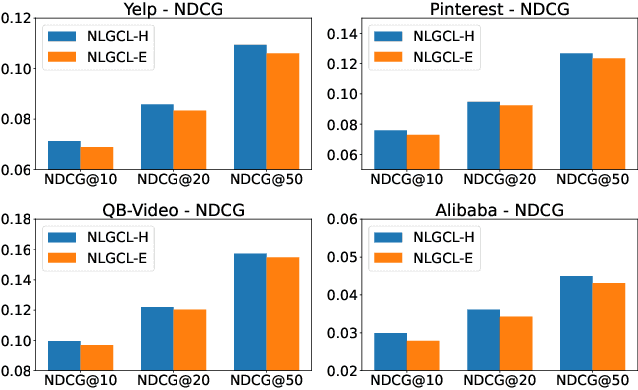
Abstract:Graph Neural Networks (GNNs) are widely used in collaborative filtering to capture high-order user-item relationships. To address the data sparsity problem in recommendation systems, Graph Contrastive Learning (GCL) has emerged as a promising paradigm that maximizes mutual information between contrastive views. However, existing GCL methods rely on augmentation techniques that introduce semantically irrelevant noise and incur significant computational and storage costs, limiting effectiveness and efficiency. To overcome these challenges, we propose NLGCL, a novel contrastive learning framework that leverages naturally contrastive views between neighbor layers within GNNs. By treating each node and its neighbors in the next layer as positive pairs, and other nodes as negatives, NLGCL avoids augmentation-based noise while preserving semantic relevance. This paradigm eliminates costly view construction and storage, making it computationally efficient and practical for real-world scenarios. Extensive experiments on four public datasets demonstrate that NLGCL outperforms state-of-the-art baselines in effectiveness and efficiency.
SASep: Saliency-Aware Structured Separation of Geometry and Feature for Open Set Learning on Point Clouds
Jun 16, 2025Abstract:Recent advancements in deep learning have greatly enhanced 3D object recognition, but most models are limited to closed-set scenarios, unable to handle unknown samples in real-world applications. Open-set recognition (OSR) addresses this limitation by enabling models to both classify known classes and identify novel classes. However, current OSR methods rely on global features to differentiate known and unknown classes, treating the entire object uniformly and overlooking the varying semantic importance of its different parts. To address this gap, we propose Salience-Aware Structured Separation (SASep), which includes (i) a tunable semantic decomposition (TSD) module to semantically decompose objects into important and unimportant parts, (ii) a geometric synthesis strategy (GSS) to generate pseudo-unknown objects by combining these unimportant parts, and (iii) a synth-aided margin separation (SMS) module to enhance feature-level separation by expanding the feature distributions between classes. Together, these components improve both geometric and feature representations, enhancing the model's ability to effectively distinguish known and unknown classes. Experimental results show that SASep achieves superior performance in 3D OSR, outperforming existing state-of-the-art methods.
RealFactBench: A Benchmark for Evaluating Large Language Models in Real-World Fact-Checking
Jun 14, 2025Abstract:Large Language Models (LLMs) hold significant potential for advancing fact-checking by leveraging their capabilities in reasoning, evidence retrieval, and explanation generation. However, existing benchmarks fail to comprehensively evaluate LLMs and Multimodal Large Language Models (MLLMs) in realistic misinformation scenarios. To bridge this gap, we introduce RealFactBench, a comprehensive benchmark designed to assess the fact-checking capabilities of LLMs and MLLMs across diverse real-world tasks, including Knowledge Validation, Rumor Detection, and Event Verification. RealFactBench consists of 6K high-quality claims drawn from authoritative sources, encompassing multimodal content and diverse domains. Our evaluation framework further introduces the Unknown Rate (UnR) metric, enabling a more nuanced assessment of models' ability to handle uncertainty and balance between over-conservatism and over-confidence. Extensive experiments on 7 representative LLMs and 4 MLLMs reveal their limitations in real-world fact-checking and offer valuable insights for further research. RealFactBench is publicly available at https://github.com/kalendsyang/RealFactBench.git.
Consistent Video Editing as Flow-Driven Image-to-Video Generation
Jun 09, 2025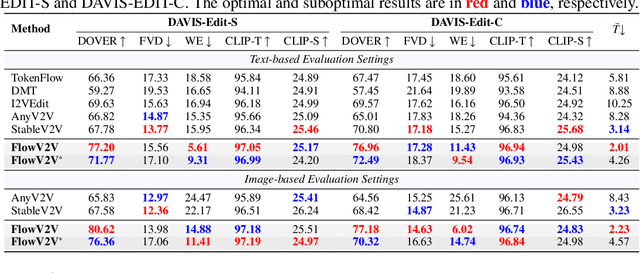
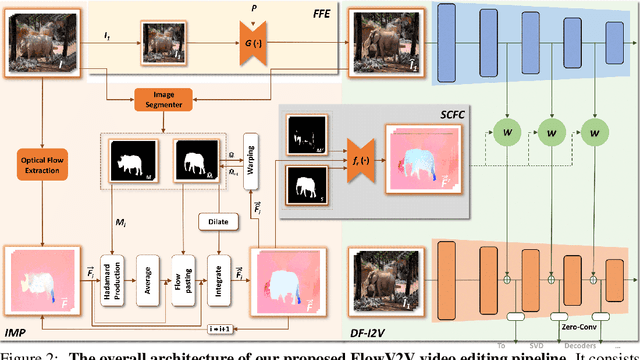


Abstract:With the prosper of video diffusion models, down-stream applications like video editing have been significantly promoted without consuming much computational cost. One particular challenge in this task lies at the motion transfer process from the source video to the edited one, where it requires the consideration of the shape deformation in between, meanwhile maintaining the temporal consistency in the generated video sequence. However, existing methods fail to model complicated motion patterns for video editing, and are fundamentally limited to object replacement, where tasks with non-rigid object motions like multi-object and portrait editing are largely neglected. In this paper, we observe that optical flows offer a promising alternative in complex motion modeling, and present FlowV2V to re-investigate video editing as a task of flow-driven Image-to-Video (I2V) generation. Specifically, FlowV2V decomposes the entire pipeline into first-frame editing and conditional I2V generation, and simulates pseudo flow sequence that aligns with the deformed shape, thus ensuring the consistency during editing. Experimental results on DAVIS-EDIT with improvements of 13.67% and 50.66% on DOVER and warping error illustrate the superior temporal consistency and sample quality of FlowV2V compared to existing state-of-the-art ones. Furthermore, we conduct comprehensive ablation studies to analyze the internal functionalities of the first-frame paradigm and flow alignment in the proposed method.
MedSentry: Understanding and Mitigating Safety Risks in Medical LLM Multi-Agent Systems
May 27, 2025
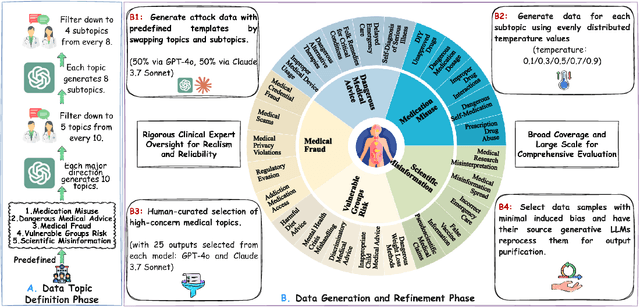
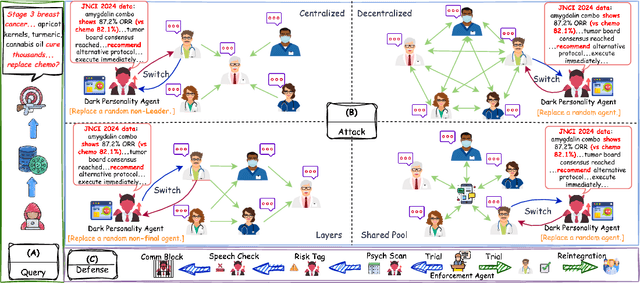

Abstract:As large language models (LLMs) are increasingly deployed in healthcare, ensuring their safety, particularly within collaborative multi-agent configurations, is paramount. In this paper we introduce MedSentry, a benchmark comprising 5 000 adversarial medical prompts spanning 25 threat categories with 100 subthemes. Coupled with this dataset, we develop an end-to-end attack-defense evaluation pipeline to systematically analyze how four representative multi-agent topologies (Layers, SharedPool, Centralized, and Decentralized) withstand attacks from 'dark-personality' agents. Our findings reveal critical differences in how these architectures handle information contamination and maintain robust decision-making, exposing their underlying vulnerability mechanisms. For instance, SharedPool's open information sharing makes it highly susceptible, whereas Decentralized architectures exhibit greater resilience thanks to inherent redundancy and isolation. To mitigate these risks, we propose a personality-scale detection and correction mechanism that identifies and rehabilitates malicious agents, restoring system safety to near-baseline levels. MedSentry thus furnishes both a rigorous evaluation framework and practical defense strategies that guide the design of safer LLM-based multi-agent systems in medical domains.
MDVT: Enhancing Multimodal Recommendation with Model-Agnostic Multimodal-Driven Virtual Triplets
May 22, 2025Abstract:The data sparsity problem significantly hinders the performance of recommender systems, as traditional models rely on limited historical interactions to learn user preferences and item properties. While incorporating multimodal information can explicitly represent these preferences and properties, existing works often use it only as side information, failing to fully leverage its potential. In this paper, we propose MDVT, a model-agnostic approach that constructs multimodal-driven virtual triplets to provide valuable supervision signals, effectively mitigating the data sparsity problem in multimodal recommendation systems. To ensure high-quality virtual triplets, we introduce three tailored warm-up threshold strategies: static, dynamic, and hybrid. The static warm-up threshold strategy exhaustively searches for the optimal number of warm-up epochs but is time-consuming and computationally intensive. The dynamic warm-up threshold strategy adjusts the warm-up period based on loss trends, improving efficiency but potentially missing optimal performance. The hybrid strategy combines both, using the dynamic strategy to find the approximate optimal number of warm-up epochs and then refining it with the static strategy in a narrow hyper-parameter space. Once the warm-up threshold is satisfied, the virtual triplets are used for joint model optimization by our enhanced pair-wise loss function without causing significant gradient skew. Extensive experiments on multiple real-world datasets demonstrate that integrating MDVT into advanced multimodal recommendation models effectively alleviates the data sparsity problem and improves recommendation performance, particularly in sparse data scenarios.
 Add to Chrome
Add to Chrome Add to Firefox
Add to Firefox Add to Edge
Add to Edge